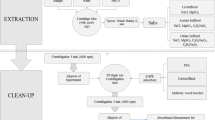Abstract
A new analytical method for the determination of 14 pesticide residues in fresh peppermint was developed based on the QuEChERS sample preparation technique followed by gas chromatography coupled to electron capture and nitrogen phosphorus detectors (GC/ECD/NPD). The validation study clearly demonstrated suitability of the method for its intended application. The overall recoveries of the pesticides from peppermint, at the three spiking levels of 0.01, 0.1 and 1.0 mg kg−1, were 100 % ± 10 % with relative standard deviations of 6 % ± 5 % on average. The limit of quantification was 0.01 mg kg−1 for all the pesticides. The expanded uncertainties were in the range between 7 % and 30 % (14 % on average), which was distinctively less than a maximum default value of ±50 %. Compared with our previous method, that entailed dichloromethane/acetone extraction and florisil column cleanup with collection of four fractions, the new method was more straightforward, less time and labour intensive as well as more sensitive, selective and accurate, simultaneously.

Similar content being viewed by others
References
Anagnostopoulos CJ, Aplada Sarli P, Miliadis GE, Haroutounian CA (2010) Validation of the QuEChERS method for the determination of 25 priority pesticide residues in cereal-based baby foods by gas chromatography with electron capture and nitrogen phosphorous detection. Hell Plant Prot J 3:71–80
Chai L-K, Zaidel N-D, Hansen HCB (2012) A rapid multi-residue method for the determination of pesticide residues in choi sum, yardlong beans and aubergines. Food Chem 131:611–616
Georgakopoulos P, Zachari R, Mataragas M, Athanasopoulos P, Drosinos EH, Skandamis PN (2011) Optimisation of octadecyl (C18) sorbent amount in QuEChERS analytical method for the accurate organophosphorus pesticide residues determination in low-fatty baby foods with response surface methodology. Food Chem 128:536–542
González-Curbelo MÁ, Hernández-Borges J, Ravelo-Perez LM, Dionis-Delgado MA (2011) Insecticides extraction from banana leaves using a modified QuEChERS method. Food Chem 125:1083–1090
González-Curbelo MÁ, Dionis-Delgado S, Asensio-Ramos M, Hernández-Borges J (2012a) Pesticide analysis in toasted barley and chickpea flours. J Sep Sci 35:299–307
González-Curbelo MÁ, Hernández-Borges J, Borges-Miquel TM, Rodriguez-Delgado MÁ (2012b) Determination of pesticides and their metabolites in processed cereal samples. Food Addit Contam A 1:104–116
Lehotay SJ, Son KA, Kwon H, Koesukwiwat U, Fu W, Mastovska K, Hoh E, Leepipatpiboon N (2010) Comparison of QuEChERS sample preparation methods for the analysis of pesticide residues in fruits and vegetables. J Chromatogr A 1217:2548–2560
Liu X, Wang X, Xu J, Dong F, Song W, Zheng Y (2011) Determination of tebuconazole, trifloxystrobin and its metabolite in fruit and vegetables by a quick, easy, cheap, effective, rugged and safe (QuEChERS) method using gas chromatography with a nitrogen-phosphorus detector and ion trap mass spectrometry. Biomed Chromatogr 65:406–409
McKay DL, Blumberg JB (2006) A review of the bioactivity and potential health benefits of peppermint tea (Mentha piperita L.). Phytother Res 20:619–633
Sadło S, Szpyrka E, Rogozińska K, Rupar J (2006) Occurrence of some pesticides residues in peppermint Mentha piperita L. in 2003–2005. Rocz Panstw Zakl Hig 57:211–216 [Article in Polish]
Srivastava AK, Trivedi P, Srivastava MK, Lohani M, Srivastava LP (2011) Monitoring of pesticide residues in market basket samples of vegetable from Lucknow City, India: QuEChERS method. Environ Monit Assess 176:465–472
Wu J, Liu Y, Zhao R, Xu R (2011) Fast pesticide multiresidue analysis in American ginseng (Panax quinquefolium L.) by gas chromatography with electron capture detection. J Nat Med 65:406–409
Xu R, Jianwei Wu, Liu Y, Zhao R, Chen B, Yang M, Chen J (2011) Analysis of pesticide residues using the quick easy cheap effective rugged and safe (QuEChERS pesticide multiresidue method in traditional Chinese medicine by gas chromatography with electron capture detection. Chemosphere 84:908–912
Author information
Authors and Affiliations
Corresponding author
Rights and permissions
About this article
Cite this article
Słowik-Borowiec, M., Szpyrka, E. & Walorczyk, S. Analysis of Pesticide Residues in Fresh Peppermint, Mentha piperita L., Using the Quick Easy Cheap Effective Rugged and Safe Method (QuEChERS) Followed by Gas Chromatography with Electron Capture and Nitrogen Phosphorus Detection. Bull Environ Contam Toxicol 89, 633–637 (2012). https://doi.org/10.1007/s00128-012-0717-5
Received:
Accepted:
Published:
Issue Date:
DOI: https://doi.org/10.1007/s00128-012-0717-5




